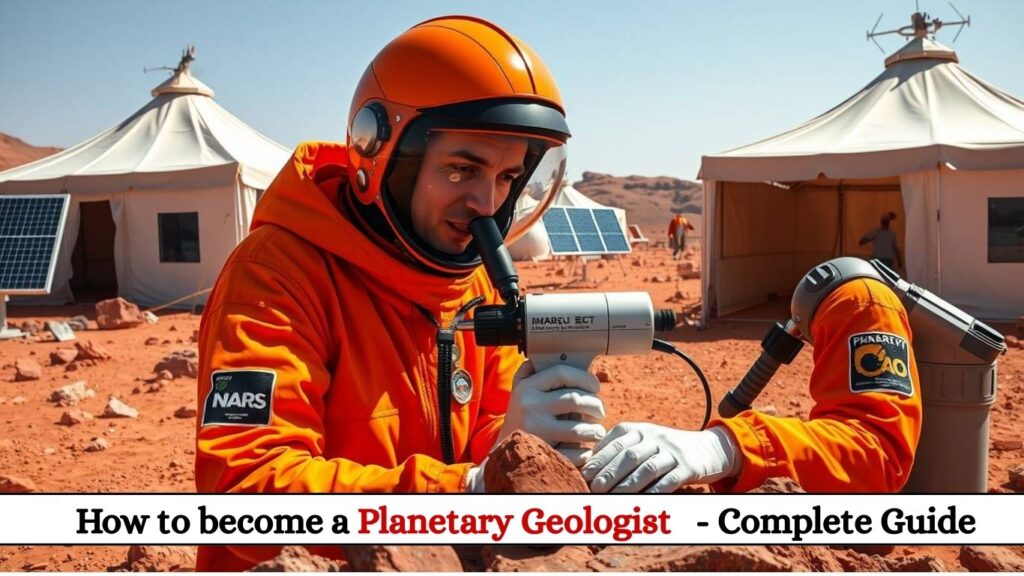
Introduction: Decoding the Secrets of Alien Worlds
Planetary geologists are the cosmic detectives of our time, studying the rocks, terrains, and geological processes of other worlds to unravel the history of our solar system and beyond. As NASA prepares for human Mars missions and commercial space exploration accelerates, demand for these specialized scientists has never been higher.
This comprehensive guide covers everything you need to launch a career in planetary geology:
- Evolution of planetary geology from lunar studies to exoplanet analysis
- Salary expectations across academia, government, and private sectors
- Day-to-day responsibilities of different specializations
- Essential qualifications and skills needed
- Step-by-step career path from student to mission scientist
- Future frontiers in planetary exploration
- Top employers and research institutions
History of Planetary Geology
Pioneering Era (1600s-1950s)
- 1610: Galileo’s lunar observations reveal mountains and craters
- 1800s: Planetary geology emerges as telescopic observations improve
- 1920s: Eugene Shoemaker proves Meteor Crater formed by impact
Space Age Revolution (1960s-1990s)
- 1960s: Mariner missions map Venus and Mars
- 1969-72: Apollo astronauts bring back 382 kg of lunar samples
- 1976: Viking landers conduct first in-situ Mars geology
- 1990s: Magellan radar maps Venus; Galileo studies Jupiter’s moons
Modern Exploration (2000s-Present)
- 2004: Opportunity rover begins 15-year Mars mission
- 2015: New Horizons reveals Pluto’s complex geology
- 2021: Perseverance rover collects Mars samples for return
- 2023: OSIRIS-REx delivers asteroid Bennu samples
Planetary Geologist Salaries (2024)
| Position | Entry-Level | Mid-Career | Senior-Level |
|---|---|---|---|
| Research Scientist | $65,000 | $90,000 | $120,000+ |
| Mission Specialist | $85,000 | $120,000 | $160,000+ |
| Professor (Tenure-Track) | $70,000 | $100,000 | $150,000+ |
| Industry Consultant | $95,000 | $140,000 | $200,000+ |
Sector Variations:
- NASA/ESA: $75k-$150k (with research funding)
- Academia: $60k-$130k (plus grant opportunities)
- Private Space Companies: $90k-$180k (SpaceX, Blue Origin)
- Mining Companies: $110k-$200k (for asteroid mining expertise)
Roles & Specializations
1. Planetary Mappers
- Create geologic maps of other worlds
- Analyze orbital imagery (HiRISE, LRO)
- Identify landing sites for missions
2. Sample Analysts
- Study extraterrestrial materials:
- Lunar samples
- Martian meteorites
- Asteroid return missions
- Use SEM, TEM, mass spectrometry
3. Field Analog Researchers
- Conduct studies in:
- Iceland (lunar analogs)
- Atacama Desert (Mars analogs)
- Deep sea vents (Europa analogs)
4. Instrument Scientists
- Develop tools for:
- X-ray diffraction (CheMin on Curiosity)
- Ground-penetrating radar
- Laser-induced spectroscopy (SuperCam)
5. Mission Operations
- Plan rover traverses
- Make real-time science decisions
- Coordinate with engineers
Essential Qualifications
Educational Pathway
- Bachelor’s: Geology + Astronomy/Physics
- Master’s: Planetary Science
- PhD: Specialized in planetary geology
Top Programs:
- Brown University
- University of Arizona
- Caltech
- Open University (UK)
- Université Paris-Saclay
Technical Skills
✔ GIS mapping (ArcGIS, QGIS)
✔ Remote sensing analysis
✔ Spectroscopy interpretation
✔ Field geology techniques
✔ Programming (Python, IDL)
Field Experience
- NASA internships (JPL, Goddard)
- Analog mission participation (HI-SEAS, MDRS)
- Museum curation work (meteorite collections)
5-Step Career Roadmap
1. Undergraduate Foundation (Years 1-4)
- Double major in geology + physics
- Join NASA Space Grant program
- Conduct summer REU research
2. Graduate Specialization (Years 5-8)
- Complete thesis on planetary topics
- Publish in Icarus or JGR: Planets
- Attend LPSC (Lunar and Planetary Science Conference)
3. Postdoc Research (Years 9-12)
- Work on active mission teams
- Develop instrument proposals
- Build professional network
4. Career Establishment (Years 13-20)
- Secure tenure-track position
- Lead research groups
- Serve on mission panels
5. Field Leadership (20+ Years)
- Direct research centers
- Shape decadal surveys
- Train next generation
Future Frontiers (2025-2040)
Upcoming Missions
- Mars Sample Return (2028-2033)
- Europa Clipper (2030 arrival)
- Venus DAVINCI+ (2031)
- Lunar Geophysical Network (2026-2030)
Emerging Specializations
🌋 Cryovolcanism Studies (Enceladus, Titan)
🧊 Exoplanet Geology (JWST data analysis)
⚒️ Space Resource Geology (asteroid mining)
Top Employers
- NASA Planetary Science Division
- ESA Human and Robotic Exploration
- JPL/APL Mission Centers
- Private Companies (Astrobotic, SpaceX)
- Research Institutions (PSI, LPI)
Conclusion: Your Passport to Other Worlds
Planetary geology offers unparalleled opportunities to be at the forefront of humanity’s greatest explorations. With 15+ active planetary missions and $3B+ in annual funding, the field is experiencing a golden age of discovery.
Key Action Items:
- Develop both classical geology and space tech skills
- Gain hands-on experience with analogs and instruments
- Build relationships with active mission teams
- Stay adaptable as new worlds come into focus
The rocks you analyze may reveal whether Mars once had life or help prepare for lunar settlements. Are you ready to leave your mark on other worlds?
This guide combines scientific rigor, career strategy, and to help aspiring planetary geologists navigate this exciting field. Would you like me to emphasize any particular aspect of planetary geology careers? 🌍🚀













Post Comment